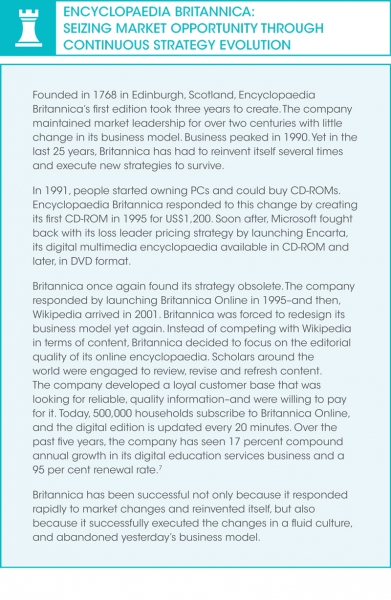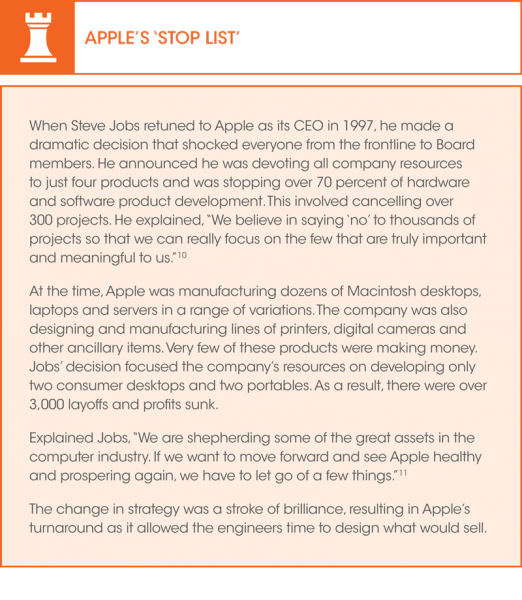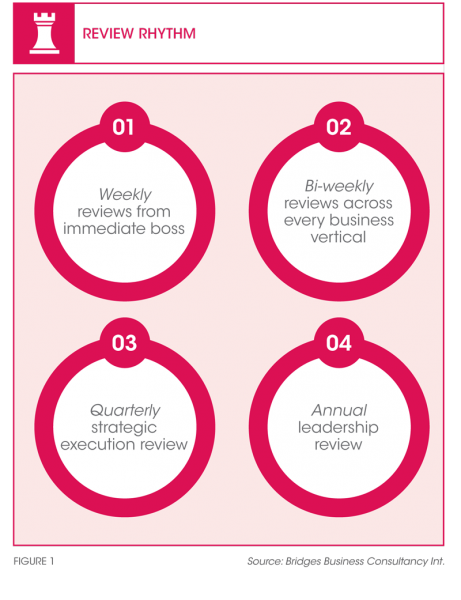When good strategies fail in execution, it’s time to consider some uncommon practices.
Strategy execution is a relatively new management subject that started to gain traction as a unique field in 1999 following the seminal article in Fortune magazine on why CEOs fail. Authors Charan and Colvin stated that strategy fails not because of bad strategy, but because of bad execution.1 The good news is that most leaders today appreciate the need to have a balance between strategy and execution. The question they are asking is: how do we achieve it?
For the last 15 years, my company, Bridges Business Consultancy Int., has been researching leaders’ insights and thoughts toward strategy implementation (I use ‘execution’ and ‘implementation’ interchangeably). In 2002, our research showed that nine out of ten implementations were failing.2 At that time, it was a wake-up call for leaders who supported the global movement towards a greater understanding on what it takes to implement strategy successfully. In our latest research we have identified that nowadays only two-thirds of implementations are failing. Although this is an improvement from 90 percent to 67 percent over the last 14 years, it still begs the questions: Why are we continuing to fail more often than we are succeeding, and what do leaders need to do differently?
We have identified some uncommon practices used by those who succeed. These practices are practical and focus on making things happen, rather than merely explaining why execution is important.
Less is more
When leaders have too many objectives on their agenda, they typically end up doing less, not more. They can become overwhelmed by the multiple actions they need to undertake. Thus more work ends up with less being done. Organisations that are dexterous in execution recognise this and limit the number of strategy objectives they focus on each year. According to Kathleen Eisenhardt of Stanford University, “There must be a certain balance to the number and type of goals and objectives: too many goals and objectives are paralysing; too few, confusing.”3 In 2015, Steve Easterbrook, the CEO of McDonald’s, explained why revenues were declining and what had to change, “Our existing organisation is is inefficient and lacks clear accountability. We need to execute fewer things better.”4
Research has demonstrated that an excess of choices often leads us to do less. Sheena Iyengar and Mark Lepper, from Columbia and Stanford University respectively, conducted the ‘jam experiment’5 that involved an upscale grocery store displaying 24 types of jam for customers to view and purchase on one occasion, and only six varieties on the other occasion. It was found that only three percent of customers purchased jams from the selection of 24, while 30 percent of customers–that is, ten times more–bought jam from the selection of six. The same experiment was also tested for choices of chocolate and, once again the group that was offered six choices had a higher level of satisfaction than that offering 24.
Too many choices in execution lead to lower engagement and performance. The question arises thus: How many strategic objectives should a leader focus on each year? I recommend having five. This ensures everyone knows what is important and the actions to take. It also allows for better resource allocation and creates a focused organisation with a critical mass of effort. The other strategic objectives–those not included in the year’s focus–should still stay in view and be addressed in regular 12-month cycles.
The magic of 90 days
There’s something magical about a 90-day period in business. Actionable tasks should not take more than 90 days to complete. If an action has not been completed within that timeframe, then it was either too complicated to complete within that period, or might not have been important enough. If a task requires more than 90 days to complete it is advisable to break it down into smaller tasks.
The aim is to ‘boil the pot’ and not to try and ‘boil the ocean’. By consciously ensuring that tasks can be completed within 90 days, leaders make actions manageable and they start to gain traction. Small, bite-size tasks are easier to achieve; it is also easier to monitor progress. Taking action in 90-day blocks also makes the long-term strategy realistic to the people responsible for execution, enables each team player to see how their work contributes to the wider strategy, and creates quick wins that are visible to all.
The aim is to ‘boil the pot’ and not to try and ‘boil the ocean'.
Adopt a framework
Leaders often return to their office after crafting the strategy without identifying a framework to guide them and their managers through the implementation journey. This leaves managers unsure of where to start, and can also result in them executing the strategy differently across business units and/or geographies. Time and resources are wasted in finding solutions, and even replicating research and methodology.
In contrast to crafting strategy, there are only a handful of tools and techniques available for executing it. Leaders should identify a framework for strategy execution that can be applied throughout the organisation. Some common frameworks include the Implementation Compass™ by Bridges Business Consultancy Int. and Kaplan and Norton’s Execution Premium. For instance, the Implementation Compass is a framework that allows the leader to identify the right actions to take, and assess the organisation’s implementation capabilities based on eight areas required for implementing strategy: engaging the people, sharing the biz case, constantly communicating, putting in place the right measures, aligning execution and culture, changing and innovating processes, reinforcing, and reviewing.6
In contrast to crafting strategy, there are only a handful of tools and techniques available for executing it. Leaders should identify a framework for strategy execution that can be applied throughout the organisation.
Constantly communicate
After the strategy kick-off, leaders often err by reverting their focus to day-today operations (disregarding discussing strategy implementation), as they are held more accountable for short-term performance, which dominates their agenda. So discussion on the implementation of strategy dissipates with alarming speed.
When employees attend meetings, there is often no mention of the new strategy, no updates are provided, and no questions are asked. When discussion on the implementation dissipates, so does the interest among people. They resort to focusing on what is being addressed– the operational issues. Their execution intentions and actions fall by the wayside and, ultimately, the strategy fails.
A balance is required between discussing operations and strategy execution, and employees need to know that execution is constantly on the management’s radar screen. We have identified that applying the discipline of constant communication has become a best practice among organisations that achieve excellence in execution. Leaders provide updates on various issues such as progress against the objectives, what is working and what is not, customer feedback, best practices, lessons learned, milestones achieved, and strategy deviations.
Abandon yesterday
In today’s dynamic business environment, leaders can no longer plan the future as an extension of yesterday. They must design new strategies and execute them more frequently than ever before.
The fact is that, in the 1950s, the average tenure of an organisation in the S&P500 was 61 years, a figure that dropped to 18 years by 2013. In 1985, 35 percent of companies listed on the S&P were considered high risk (risk being based on the ability to achieve long-term stable earnings growth). This number rose to a whopping 73 percent in 2006, even prior to the Global Financial Crisis. By 2006, only 13 percent were considered low risk, compared to 41 percent in 1985. As agonisingly difficult as it is, we must be prepared to release the past and seize the future. This calls for a resilient operating model that can be adapted, modified, radically changed or abandoned, in response to a change in strategy.


To Do or Not to Do
Peter Drucker coined the term ‘purposeful abandonment’ in which he proposed, “The first step in a growth policy is not to decide where and how to grow…it is to decide what to abandon. In order to grow, a business must have a systematic policy to get rid of the outgrown, the obsolete and the unproductive.”8
Part of achieving excellence in execution is telling people what to stop doing and empowering them to decide when it is appropriate to kill a project or task. Everyone has a ‘to do’ list; but one should also be aware of the need for a ‘to stop’ list of the actions that don’t contribute to the new strategy. When Piyush Gupta launched the DBS strategy in 2011 he not only explained what had to be done, but also talked about the businesses that the bank was exiting because they were not aligned with the new strategy. As CEO of Procter & Gamble, Alan Lafley also turned around the company by narrowing down its focus to just four core businesses, and simultaneously creating, “a ‘not-to-do’ list including projects that were driven by technology rather than customer needs”.9
Creating a ‘to stop’ list involves empowering employees to identify and eliminate work that has become obsolete or is not adding value. To make this happen, employees should be encouraged to present the work they want to kill off to their immediate supervisor and the leaders of the specific business. When you empower your people to stop doing non-value adding work, they become more engaged, they are able to accomplish more in less time, and you are able to create the right conditions for achieving excellence in execution.
Everyone has a ‘to do’ list; but one should also be aware of the need for a ‘to stop’ list of the actions that don’t contribute to the new strategy.

Review rhythm
Tracking and monitoring progress is an integral part of execution. The frequency of execution reviews is a key step in achieving excellence in execution and, unbelievably, most leaders don’t spend enough time reviewing the execution. Our research reveals that 85 percent of organisations spend less than 10 hours a month discussing execution.12
Conducting regular reviews creates the review rhythm–a pattern and expectation that progress is checked. Coupled with the 90-day window to complete a task, this becomes the momentum behind the execution. It tells people that they are going to be asked on how they are progressing against the actions they have identified to take every 90 days, and allows for support and coaching. Organisations that excel in execution tend to broadly adopt the review rhythm outlined below (refer to Figure 1):
Weekly reviews, where leaders need to be asking their direct reports every week on what they are doing to contribute to execution.
Bi-weekly reviews across every business vertical to ensure the organisation has the discipline and is taking the right actions. It allows for immediate corrective action, support such as resource allocation, and reinforcement of the right actions.
Quarterly strategic execution reviews that involve top leaders and invited employees. It encapsulates the discussions and actions from the bi-weekly reviews across all the business verticals and provides a summary of the progress being made across the whole organisation. It may also identify flaws in the strategy that need to be corrected, and collectively examines the feedback from the bi- weekly reviews.
Annual leadership reviews are a learning opportunity to reflect on performance, share best practices and lessons learned, and embed changes. They bring the key players in the execution together and is leveraged to celebrate and share successes.

Make execution planning part of strategy planning
Leaders are responsible for decoding the execution challenge by pre-empting and outlining what needs to be achieved, and then guiding the organisation through the entire implementation journey. This means that the leaders need to know what is involved and required even before execution begins. Roger Martin, former dean of the Rotman School of Management at the University of Toronto, states, “It’s impossible to have a good strategy poorly executed. That’s because execution actually is strategy. Trying to separate the two only leads to confusion.”13
Yet, leaders often exclude the execution plan in their strategy planning because they’ve been taught how to plan, not how to execute, and because they sometimes misjudge what is involved and required. It is advisable to postpone the launch of a strategy until one has developed a solid execution plan. Otherwise leaders find themselves struggling after the launch: What do they do first? Where should they allocate resources? Should they focus on communicating the new strategy? Do they need to provide new skills training? Should they put in place new measures? The uncertainty in being unable to answer these typical questions breeds discontent and lack of motivation. That in turn undermines any opportunity for the new strategy to gain traction.
Former CEO of GE, Jack Welch, put it succinctly when he said, “In real life, strategy is actually very straightforward. You pick a general direction and implement like hell.”14 Yet leaders need to know how to implement like hell.
A good strategy well executed transforms challenging, confusing and complicated tasks to engaging, enjoyable and achievable ones.
Achieving excellence in execution
Taking time to develop your execution plan doesn’t dilute from strategy planning, as some leaders think, in fact it adds tremendous long-term value. The enriched conversation among the leadership results in:
- Further defining and refining the strategy for all leaders
- Stating what needs to be done in more detail to achieve excellence in execution
- Detailing the expected timeline of execution
- Clearly articulating the strategy outcomes
- Specifying individual responsibilities
- Starting the implementation journey with the right resources and capabilities
- Building buy-in and confidence across the organisation
A good strategy that is well executed transforms challenging, confusing and complicated tasks to engaging, enjoyable and achievable ones. It decodes the ambiguity of execution, gives everyone focus, and dramatically increases the odds for success, especially when it is developed with the same intensity and energy as the strategy itself. It also helps to demonstrate progress: as tasks are accomplished and the to-do list shortens, teams begin to energise as they witness the realisation of long-term goals. Thus excellence in execution can be a differentiator in business—and the payoff can be tremendous.